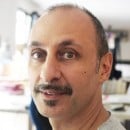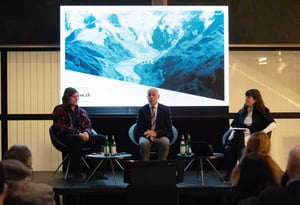On November 26 Julian Charrière, one of the most innovative Swiss artists of his generation, and Felix Keller, Professor at the ETH in Zurich and glaciologist, who has been conducting research on the melting of glaciers for many years, met at the LAC in Lugano to speak about science, art and climate change. The event was moderated with great skill by Dehlia Hannah, researcher and science philosopher, who focused the attention of the two guests on several specific topics.
Below is a comprehensive summary of their conversation.
What led to our interest in glaciers
Charrière
The voyage by boat to the Antarctic was extraordinary: we didn’t know what to expect, giant pieces of ice suddenly coming out of the dark, which would appear and then disappear… A drone filmed the landscape, while another one immortalised these very brief moments of light and shadow. All of this work was a source of inspiration for recreating something artistic. All things considered, both Keller and I are trying to save and protect an image: the glaciologist tries to do so with technological apparatus.
Keller
There is a romantic side, but there is also a logical and rigorous side in the preservation of glaciers. As a young child I loved seeing lots of snow, the glacier is a landscape that is part of my heart: you can see and you can feel the vibrations of glaciers…
But what are the motivations that entice me to work? I have understood that glaciology can be an important field of research: it is fundamental to know how water behaves, because in many regions glaciers are about to disappear. I learnt from the people of Ladakh, in India, that you need to be part of the solution. There is a big gap between the knowledge of climate change and what we are doing about it: we have to change our view and if we are able to turn the climate change discussion into a positive one, we will have more energy to fight this problem.
The vision of the artist
Charrière
In my opinion, there are too many images that render the Poles mundane. I decided to create a new, very different story that showed the fragility and magic of these places. To do this, I used a drone.
The first time I found myself faced with this landscape I felt intimidated, for me the ice is special… I work on many subjects, but not on the construction of this environment, which I think is already too constructed… I wanted to play with the clichés, create a new visual, within this fictitious construction.
The view of a transformed world
Charrière
If we think about the bears, the wolves, those are animals that are disappearing because of our species. We won’t be able to survive without cooperating. We have already gone one step too far: now we have to understand how we can adapt to these problems.
Keller
We have no alternative, we have to collect fresh water, maybe we ought to change the way it is collected. Glaciers have to be maintained as a freshwater reserve for future generations, and with the MortAlive project we need systems that produce 30,000 tonnes of snow without electricity. It is with projects like this that we can look to the future differently, with renewed enthusiasm.
The emotions transmitted by art in its relationship with environmental changes
Charrière
Artists have to go out there, do fieldwork, expose themselves. For me the element of danger is not important: I have to create something within a broader system. Artists can react and create new realities: that is why I decided to work at night. I wanted to show the dark side of the polar region. The night is like something extra-terrestrial: there are times when you have total darkness for 24 hours, where it is like a grey curtain, with a strange color palette. I wanted to create a known space, create a particular image field… The project had a very intuitive aspect, you felt disorientated, which made you float in an unknown environment… We followed things slowly slowly, things that melted within one another… All these things motivated me to make this project.
Keller
We never work at night. But I have had special experiences with Permafrost (editor’s note: ground that is permanently frozen). Our project isn’t a solution, because the volumes and masses of ice are enormous… On the other hand, because we are doing something, it creates a lot of motivation, which leads us to do something against climate change.
There is a secret relationship between music and glaciers
Keller
At every glaciological congress I have been to scientists have produced music: everyone wants to play music, because both music and glaciers are a part of their hearts. I don’t know why. Maybe the blue vibrations are responsible for producing music in scientists…
Charrière
I put a microphone under the glacier. Then I worked with a producer from Berlin. The result? A sort of fusion of real and imaginary sounds, in imaginary landscapes. At times you can hear a snowflake melting on the microphone. Or the deafening noise of an iceberg moving…

